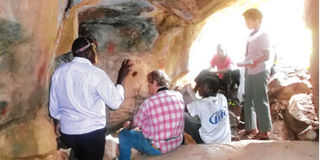Rock art on the Kitengela plains

Inside the cave. Photo/RUPI MANGAT
What you need to know:
- Rupi Mangat takes a trip to Enkinyoi to explore the ancient art of the Maasai people
A beautiful spotted cat stalks prey on a track in the Nairobi National Park. The cat, a serval with pointed ears, is on the hunt using the clear road as a vantage point. It spots its prey and, with a leap, vanishes into the long grass.
I have only seen this elusive cat twice — both times in Tsavo West, but only in its melanistic form — that is pure black. A strong cat, the serval has large ears and long legs relative to its body size. One of its sub-species, the barbary serval, only found in Algeria, is endangered, if not already extinct.
We are using the park to bypass the city on our way to the Athi-Kitengela plains in search of ancient rock art. I am in the company of David Coulson, the founder and executive chairman of the Trust for African Rock Art (TARA).
Sacred to the moran
Together with us are his assistants — William Omoro, who deals with community awareness, Evan Maina, an archaeologist, Jagi Githinji, the driver, Paula Kahumbu, the chairperson of Friends of Nairobi National Park (FoNNAP), and Nickson ole Parmisa, a FoNNaP member recently appointed as a Maasai chief. Mr ole Parmisa guides us to the site in Ololoitikoshi on the Athi-Kitengela plains, 14.35 kilometres as the crow flies southeast of Nairobi.
Away from the shanty town of Athi and its myriad of cement factories, the grass plains open up. The Maasai lead their cattle to pasture and water.
The traditional manyatta, made of cow dung and earth, have been replaced with mabati houses. An hour later, we halt at a lone hut where three young Maasai wait to guide us to the rock art site hidden in a ravine.
“We call this place Enkinyoi,” says Isaac Malit. “In Maa, it means a ‘place where there is always water’.”
It is a deep gorge. Scrambling down to the river, we see the caves that house the ancient rock art. It is another scramble to reach the deeper gorge. From this angle, we can look up at the boulders where we were a few minutes ago.
The waterfall plunges into a pool and continues downstream. The caves on the side are dark. We enter and, using flash lights, we see faint white etchings on the cave walls juxtaposed with red ochre hand prints belonging to the current homo sapien.
“This is a place where Maasai morans come to slaughter cows and feast,” says Malit, whose ambition is to be a lawyer. The hand prints belong to the morans.
“The young men leave their marks because they say that as the old left a message, so should they,” explains Parmisa.
Richest continent
Most rock art sites are protected by law and must not be tampered with. Looking closely at them and photographing the etchings, Coulson is impressed.
“This is an amazing site for its caves, water and the mystery of the art,” he remarks. “It’s fascinating to think what this place might have meant to the people — could it have been spiritual?
These concentric patterns are not typically done by Maasai but by the Dorobo/ Twa, hunter-gatherers who lived all over East Africa and left lots of geometric symbols or patterns in caves. The best examples are on the islands of Lake Victoria, which were used for rain-making until the 1890s.”
By Coulson’s educated guess, the rock art engravings in these caves are only a few hundred years old, unlike some of the older ones found on the continent dating back thousands of years.
Africa is the richest continent for rock art today and most sites are protected, thanks to the efforts of people like Coulson.
He was introduced to this ancient art by the legendary Mary Leakey, famous for her work in finding fossils and the Laetoli footprints of three individuals dating back 3.5 million years, which are the earliest record of human ancestors going bipedal.
Coulson, a professional photographer, has gone on to capture rock art images on the continent — many never seen before, like the life-size giraffes of Niger on a high rock dating back between 7,000 and 10,000 years.
Coulson does not claim to be an academic, but feels compelled to create awareness about this ancient heritage and, as a photographer, to reach a global audience.
“Rock art is all we know of Africa’s past,” he says. The acclaimed photographer, illustrator, and writer has been climbing rocky mountains and gorges — many inaccessible to ordinary people — for the past four decades because that is where most of the best preserved rock art is found.




